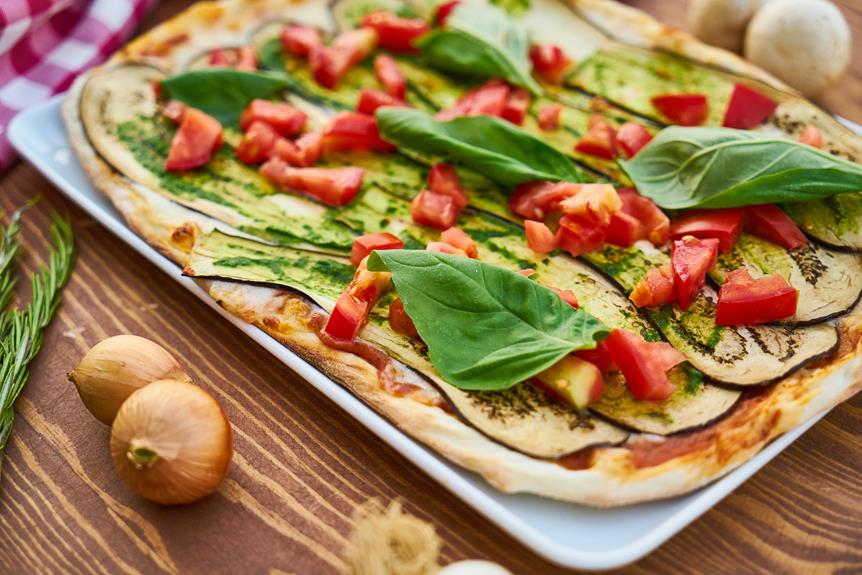Do you ever wonder what's really in your favorite slice of pizza?
In this article, we'll dive into the ingredients of pizza and explore whether it contains red dye 40.
With its vibrant color and potential health effects, red dye 40 has been a topic of concern for many.
By examining the common foods that contain it and its impact on your well-being, we'll uncover the truth about pizza and its relationship with this controversial ingredient.
Get ready to satisfy your curiosity and make informed choices about your food.
What Is Red Dye 40
Red Dye 40 is a commonly used food coloring that you may have encountered in various products. It's a synthetic dye that gives food a vibrant red color.
While it may make food more visually appealing, there are both pros and cons to consuming Red Dye 40. On the positive side, it allows for a wide range of colorful food options and can enhance the overall eating experience.
However, there are concerns about its potential negative effects. Some studies suggest that Red Dye 40 may cause hyperactivity and behavioral issues in children, although more research is needed to confirm these claims.
Additionally, Red Dye 40 is often found in processed snacks, which are typically high in sugar and unhealthy ingredients. Therefore, it's important to consider the presence of Red Dye 40 when making food choices, especially if you're trying to maintain a healthy diet.
Common Foods Containing Red Dye 40
When ordering pizza, you may be surprised to learn that many common toppings contain the food coloring Red Dye 40. This artificial color is widely used in the food industry to enhance the appearance of various products.
Here are some common foods that contain Red Dye 40:
- Tomato-based sauces: Red Dye 40 is often added to give tomato sauces a vibrant red color, including those used on pizza.
- Candy: Many candies, such as gummy bears, fruit snacks, and red-colored hard candies, rely on Red Dye 40 for their bright hues.
Consuming foods that contain artificial colors like Red Dye 40 may pose potential risks. Some studies suggest that it could cause allergic reactions, hyperactivity in children, and even contribute to certain types of cancer. It's important to be mindful of the ingredients in the foods we consume and consider the potential effects they may have on our health.
Red Dye 40 and Its Potential Health Effects
To understand the potential health effects of Red Dye 40, it's important to be aware of its presence in various food products.
Red Dye 40, also known as Allura Red AC, is a synthetic food coloring commonly used in a wide range of processed foods, including candies, desserts, beverages, and even medications.
While the FDA has deemed Red Dye 40 safe for consumption, some studies suggest potential risks associated with its use. These studies have linked Red Dye 40 to hyperactivity in children, allergic reactions, and even cancer in animal studies.
However, it's worth noting that most of these studies have been conducted on animals or in controlled laboratory settings, and more research is needed to fully understand the impact on human health.
In the meantime, if you're concerned about the potential risks of Red Dye 40, you can opt for foods and beverages that use natural food colorings or explore alternatives to Red Dye 40, such as beet juice, turmeric, or paprika extract.
The Ingredients of Pizza
If you're curious about the ingredients of pizza and how they might relate to the topic of Red Dye 40, let's dive right in.
Pizza, a beloved dish enjoyed worldwide, consists of various ingredients that come together to create a flavorful experience. When it comes to cheese types, the most commonly used on pizza are mozzarella, cheddar, and Parmesan. These cheeses not only add richness and creaminess to the pizza but also provide a stretchy texture that's loved by many.
The pizza dough, on the other hand, is made using a combination of flour, water, yeast, and salt. This dough is then kneaded and left to rise, resulting in a soft and chewy crust that serves as the foundation for the toppings.
Understanding the ingredients of pizza allows you to appreciate the craftsmanship and thought that goes into each slice, making it all the more enjoyable.
Does Pizza Contain Red Dye 40?
Does pizza include any traces of Red Dye 40? It's natural to wonder about the presence of this food coloring in one of your favorite dishes.
The good news is that pizza generally doesn't contain Red Dye 40. While this dye is commonly found in a variety of processed foods, such as candies, soft drinks, and desserts, it isn't a typical ingredient in pizza. Pizza typically gets its red color from natural ingredients like tomatoes and tomato sauce.
However, if you're concerned about consuming Red Dye 40, there are potential alternatives available. Some pizza brands offer options made with natural food coloring or without any added colors. So, if you want to avoid Red Dye 40, it's worth checking the ingredient list or exploring alternative pizza options.

